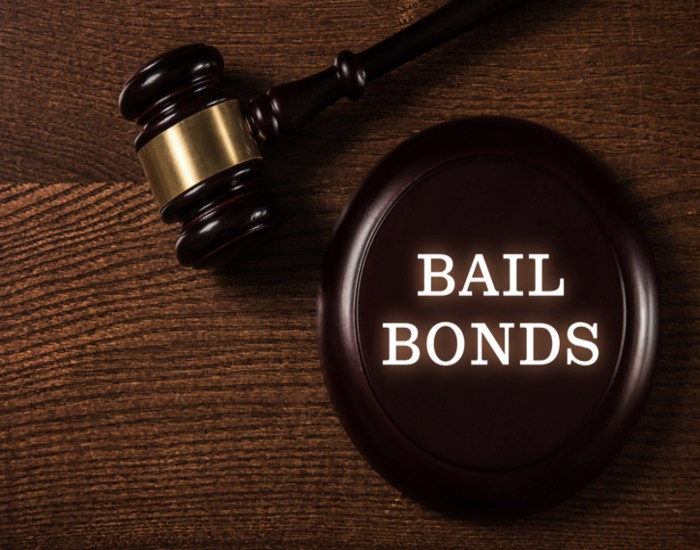A Comprehensive Look at the Bail Bonds Process in Los Angeles
A Comprehensive Look at the Bail Bonds Process in Los Angeles
Blog Article
How Bail Bonds Work: A Comprehensive Summary
Bail bonds play a crucial duty in the lawful process by offering a system for individuals to safeguard their release from protection while waiting for trial. Recognizing the complexities of how bail bonds work, consisting of the functions of courts, bail bondsmensman, and the different fees entailed, can be crucial for anybody browsing this complicated system. As we check out the different types of bail bonds and the elements that affect their expenses, it becomes evident that the duties connected to these agreements prolong much past mere economic deals. What implications do these responsibilities hold for offenders and their households?
What Are Bail Bonds?
Bail bonds are often made use of in the criminal justice system as a financial assurance that an accused individual will certainly show up in court as needed. When a person is detained, a judge may establish a bond quantity based on various variables, consisting of the severity of the violation, the accused's criminal history, and the threat of trip. If the implicated can not pay for the bail quantity, they may look for the support of a bail bondsman.
A bail bond is an agreement in between the accused, the bail bondsman, and the court, making certain that the offender will accomplish their lawful commitments. In exchange for a cost, commonly a percent of the overall bail amount, the bondsman offers the court with a guaranty that guarantees the bail. If the accused fails to appear in court, the bail bondsman is accountable for paying the full bail amount to the court, which may lead them to seek the offender for recuperation.
Bail bonds offer to help with the launch of individuals waiting for trial, allowing them to maintain their employment and family members responsibilities while guaranteeing compliance with court looks. This system is indispensable to stabilizing the legal rights of the accused with the rate of interests of public safety and judicial stability.
The Bail Process Clarified
After recognizing the function of bail bonds in the criminal justice system, it is necessary to lay out the bail procedure itself. The bail process starts when a person is detained and apprehended. Following the apprehension, the offender is usually brought prior to a court for an initial hearing, where the judge will determine whether to approve bail and set the amount.
If bail is given, the offender has numerous choices to secure their launch. They may pay the full bail amount in money, which is returned upon the conclusion of their court commitments. The accused can seek the assistance of a bail bondsman, who charges a non-refundable charge-- typically a percent of the overall bail quantity-- to post bail on their behalf.
Once bail is posted, the offender is released from protection with the understanding that they need to participate in all arranged court appearances. Falling short to show up can cause the forfeiture of the bail and extra lawful effects. The procedure concludes when the instance is resolved, at which point the bail is either returned or retained by the bail bondsman as payment for their solutions.

Sorts Of Bail Bonds
Various choices exist when it pertains to protecting a release from guardianship with bail bonds. Recognizing the various types can assist accuseds and their families make educated choices.
The most usual kind is the surety bond, which entails a third-party bail bondsmansman who assures the complete bail amount to the court for a non-refundable fee, commonly around 10% of the bail amount. This alternative is extensively used due to its availability for individuals who might not have the economic methods to pay the full bail upfront.
One more type Continue is the money bond, where the accused or a co-signer pays the total bail amount in money directly to the court. Upon effective conclusion of the situation, the funds are reimbursed, minus any relevant fees.

Finally, immigration bonds are particularly made for people apprehended by immigration authorities, promoting their release while they await lawful proceedings. Each kind of bail bond serves distinctive objectives, dealing with various circumstances and needs within the lawful system.
Aspects Influencing Bail Expenses
A number of crucial variables affect the overall cost of bail, identifying just how a lot a defendant or their family might require to pay for launch. One of the key variables is the seriousness of the fees. Felony fees typically lead to higher bail quantities contrasted to violations as a result of the perceived risk of trip and the possible consequences of the violation.

The offender's economic situation can additionally affect the bail amount. Courts might think about an offender's earnings and possessions when figuring out bail, potentially resulting in higher expenses for those with higher funds. The schedule of collateral might influence the needed settlement. If a bondsman views a higher threat, they might establish a greater premium, further enhancing the expenses connected with protecting a bail bond. Recognizing these variables can help defendants and their families get ready for the economic implications of safeguarding bail.
Responsibilities of the Indemnitor
Once bail has been safeguarded, the duties of the indemnitor, or the individual that consents to back the bail bond, entered play. The indemnitor is mostly her response in charge of making certain that the accused goes to all scheduled court looks. Failing to do so may cause the forfeiture of the bail bond and potential lawful consequences for the indemnitor.
In addition, the indemnitor is bound to repay the bail bond firm the sum total of the bond if the defendant stops working to appear in court. This consists of any expenses or fees sustained by the bail representative in recouping the defendant, which might better escalate the monetary burden on the indemnitor.
The indemnitor should also maintain open communication with both the accused and the bail bail bondsman, providing any type of needed updates connected to the accused's scenario. It is essential for the indemnitor to continue to be familiar with the lawful commitments and repercussions linked with the bail bond, as ignorance might cause unintended obligations.
Final Thought
In summary, bail bonds work as a vital system within the criminal justice system, facilitating the release of defendants while guaranteeing their appearance in court. Comprehending the numerous types of bail bonds, the details of the bail procedure, and the elements influencing bail costs is important for navigating this complicated landscape. Additionally, recognition of the responsibilities birthed by the indemnitor highlights the importance of educated decision-making when involving with bail bond solutions.
Comprehending the ins and outs of just how bail bonds operate, consisting of the duties of courts, bail bondsmen, and the numerous fees included, can be important for any person browsing this complicated system.After recognizing the duty of bail bonds in the criminal justice Learn More system, it is crucial to outline the bail process itself. The accused can look for the support of a bond bondsman, who charges a non-refundable fee-- typically a percent of the complete bail quantity-- to publish bail on their part.
If a bond bondsman perceives a higher danger, they might set a greater costs, additional enhancing the costs associated with safeguarding a bail bond. Recognizing the numerous kinds of bail bonds, the intricacies of the bail process, and the variables influencing bail prices is important for navigating this facility landscape.
Report this page